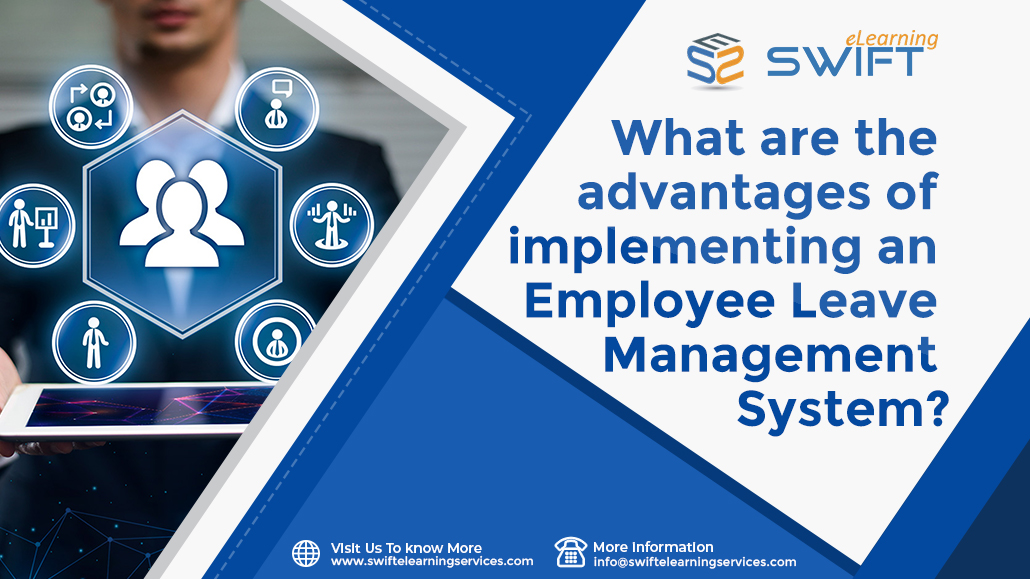What are the advantages of implementing an Employee Leave Management System?
In the dynamic landscape of today’s corporate world, the efficient management of employee leave has evolved into a pivotal aspect of human resource management. The manual and cumbersome processes of yesteryears have given way to the innovative Employee Leave Management System, a technological marvel that brings an array of benefits for both employers and employees alike.
This blog post delves deep into the multifaceted advantages of implementing such a system, shedding light on how it bolsters productivity, augments transparency, alleviates administrative burdens, and cultivates employee contentment. Before that, let us have a look at the significance of an employee leave management system.
1. The Significance of an Employee Leave Management System
The significance of an Employee Leave Management System lies at the very core of modern workforce management. In an era where organizations strive for operational excellence and employee well-being, this digital solution emerges as a linchpin that orchestrates harmony between productivity, transparency, and efficiency.
By automating the intricate processes of leave request, approval, and tracking, this system alleviates the administrative burden that often plagues HR departments. This, in turn, liberates HR professionals to focus on strategic initiatives that drive the organization forward, rather than being mired in manual paperwork and calculations.
Furthermore, the strategic implications of an Employee Leave Management System extend beyond day-to-day operations. It equips organizations with a data-driven lens into workforce dynamics, providing insights into leave patterns, utilization rates, and peak periods of absence.
Armed with this intelligence, businesses can make informed decisions about resource allocation, workforce planning, and staffing strategies. This proactive approach mitigates disruptions, enhances overall productivity, and contributes to efficient resource management during times of fluctuating workloads.
Perhaps most significantly, an Employee Leave Management System reinforces the employer-employee relationship by fostering a culture of transparency and trust. Employees experience heightened engagement when they encounter a seamless leave request process, promptly processed approvals, and real-time visibility into their leave balances. This translates to improved job satisfaction, higher morale, and reduced instances of leave-related disputes.
As organizations increasingly prioritize employee well-being and work-life balance, the adoption of such a system underscores a commitment to valuing and nurturing their most valuable asset: their workforce.
2. Advantages of Implementing an Employee Leave Management System
2.1 Streamlined Leave Request Process: A Paradigm Shift in Efficiency
The archaic days of paper-based leave request submissions and labyrinthine email threads are now a thing of the past. The advent of the Employee Leave Management System has revolutionized this landscape. By empowering employees to effortlessly apply for leave through a user-friendly digital interface, the system ushers in a new era of streamlined processes.
Through this, requests are methodically documented, and the spectre of errors is dramatically reduced. Within the digital framework, employees can seamlessly input their desired type of leave, the dates they intend to be absent, and any pertinent remarks. This, in turn, facilitates managers in meticulously reviewing and subsequently approving these requests.
2.2 Efficient Leave Approval Workflow: Navigating the Seas of Decision-making
A hallmark of the Employee Leave Management System is its ability to facilitate an efficient and structured workflow for leave approvals. In this intricate mechanism, supervisors are promptly notified of pending leave requests, allowing them to expeditiously deliberate and decide. This deters bottlenecks and ambiguities, as managers can holistically assess the team’s availability before according to their seal of approval.
Furthermore, the system meticulously maintains a digital breadcrumb trail of these approvals, acting as an impervious testament to the transparency and robustness of the decision-making process.
2.3 Accurate Leave Balances: The Calculus of Precision
The days of manual and error-prone leave balance tracking are numbered, thanks to the revolutionary Employee Leave Management System. This digital marvel provides real-time updates on the reservoir of available leave balances, taking into account an array of factors including earned leaves, sick leaves, and compensatory leaves.
This unwavering accuracy ensures that both employees and managers are equipped with the most up-to-date information when making crucial decisions regarding leave utilization.
2.4 Enhanced Resource Planning: Orchestrating Organizational Symphony
One of the linchpins of an Employee Leave Management System is its profound impact on resource planning. Managers are bestowed with a panoramic view of their team’s leave schedules, enabling them to adroitly allocate tasks and projects.
This strategic orchestration of work prevents the undue burdening of employees during pivotal periods and guarantees the seamless continuation of operations, even in the face of team members being on leave.
2.5 Reduced Administrative Burden: A Breath of Fresh Air for HR Professionals
Gone are the days where HR professionals were ensnared in the quagmire of laborious manual processes. The Employee Leave Management System is a lifeline in reducing administrative overhead.
By automating an array of tasks, including the processing of leave requests, record updates, and leave balance calculations, HR professionals are emancipated from the drudgery of redundant tasks. This liberation paves the way for these professionals to focus on higher-value strategic endeavours.
2.6 Compliance with Leave Policies and Regulations: A Legal Compass
One of the most salient features of the Employee Leave Management System is its ability to function as a bastion of compliance. This digital sentinel can be deftly configured to reflect and uphold the intricacies of company-specific leave policies and legal stipulations.
The system’s unwavering adherence to rules, such as maximum leave accruals and the requisites for medical leaves, ensures that all leave-related processes are not only in lockstep with organizational guidelines but also consonant with prevailing labour laws.
2.7 Data-Driven Insights: Illuminating Workforce Trends
Data serves as an invaluable catalyst in the realm of decision-making. The Employee Leave Management System acts as a reservoir of data, capturing intricate leave patterns, utilization rates, and zeniths of leave-taking.
The judicious analysis of this trove of information unveils profound insights into workforce trends, empowering organizations to proactively address seasonal variations and optimize the ebb and flow of staffing levels.
2.8 Improved Employee Satisfaction: Nurturing a Contented Workforce
An often-overlooked facet of the Employee Leave Management System is its propensity to significantly amplify employee satisfaction. By rendering the leave request process seamless and expeditious, employees experience heightened engagement and morale. The underpinning transparency of leave policies fosters a sense of equitability and trust, engendering a milieu of job satisfaction within the organization.
2.9 Remote Work and Flexibility Support: Tailoring to Modern Realities
In the contemporary paradigm characterized by remote work and flexible schedules, the need for an adaptable leave management system is more pronounced than ever.
Employee Leave Management Systems deftly adjust to this dynamic by allowing employees to request remote workdays and calibrate their leave balances to align with evolving work arrangements. This accommodation not only nurtures a harmonious work-life balance but also tacitly acknowledges the evolving contours of the modern workplace.
2.10 Integration with Payroll and Attendance Systems: The Symphony of Integration
The seamless integration of the Employee Leave Management System with payroll and attendance systems ushers in a new era of efficiency. The unerring accuracy of leave records ensures that compensation calculations are unfailingly precise, effectively circumventing discrepancies and disputes related to paid time off.
2.11 Security and Data Confidentiality: Safeguarding the Digital Vault
The digital realm is fraught with concerns regarding data security. The architects of Employee Leave Management Systems prioritize the sanctity of data confidentiality through the implementation of robust encryption and stringent access controls.
This fortification ensures that sensitive employee information remains impervious to unauthorized access.
2.12 Scalability for Growing Organizations: Navigating the Waters of Expansion
As organizations surge forward on their growth trajectory, the complexity of leave management burgeons in tandem. The Employee Leave Management System rises to the occasion by virtue of its innate scalability.
This adaptability ensures that as the organization burgeons in size, the efficiency and efficacy of the system remain unwavering, fostering sustained growth without compromising operational dexterity.
3. Conclusion
In the grand tapestry of modern HR practices, the implementation of an Employee Leave Management System emerges as a pivotal thread. From ushering in the era of streamlined processes to engendering employee well-being, these systems bestow an array of advantages.
As organizations set their compass towards greater efficiency, transparency, and flexibility, embracing the transformative potential of a well-structured Employee Leave Management System stands as a testimony to astute decision-making and a resolute commitment to holistic organizational excellence.
Frequently Asked Questions (FAQs)
What is an Employee Leave Management System?
An Employee Leave Management System is a digital platform that automates and streamlines the process of requesting, approving, and tracking employee leave within an organization.
How does an Employee Leave Management System enhance efficiency?
By replacing manual processes with a user-friendly digital interface, the system simplifies leave requests, approvals, and tracking, reducing errors and administrative burdens.
What role does transparency play in leave management?
An Employee Leave Management System fosters transparency by notifying supervisors of pending requests, ensuring fair decision-making, and maintaining a digital record of approvals.
How does the system ensure accurate leave balances?
The system provides real-time updates on available leave balances, taking into account various types of leaves, thus preventing errors in leave calculations.
How does an Employee Leave Management System aid in resource planning?
The system offers managers a comprehensive view of team leave schedules, enabling them to allocate tasks effectively and maintain operational continuity.
What benefits does it offer HR professionals?
The system reduces administrative burden by automating leave-related tasks, allowing HR professionals to focus on strategic initiatives and value-added activities.





Leave a Reply
Want to join the discussion?Feel free to contribute!